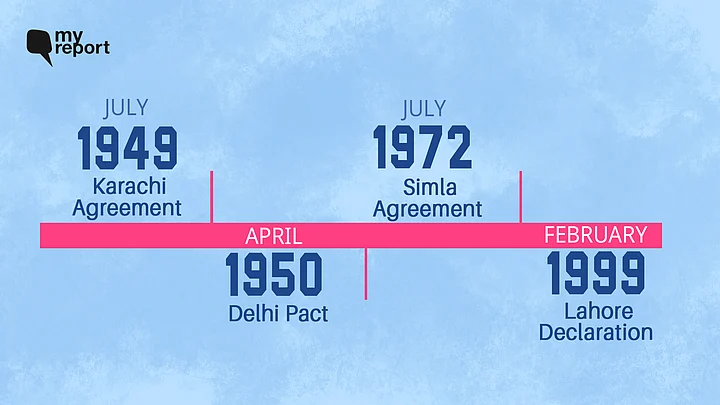After Pulwama, the Balakot air strikes, and the very real concern about a potential escalation into nuclear war, it’s clear that instead of abating, the dynamic between India and Pakistan is deteriorating. So, what’s the best way to normalise relations?
Here’s a look back at past attempts to make peace in the subcontinent, and the events that preceded them.
Indo-Pak War of 1947 and the Karachi Agreement of 1949
Between India and Pakistan, Kashmir been a theatre of war thrice. Following India‘s independence in August 1947, the future of Kashmir was uncertain – the then-ruler Maharaja Hari Singh was on the fence about whether to join India or Pakistan.
But after tribesmen from Pakistan invaded Kashmir, he signed the Instrument of Accession on 27 October 1947, signing over Jammu and Kashmir to India. Here on, already simmering tensions gained momentum. On 1 January 1948, the United Nations intervened to mediate the conflict and initiate a ceasefire.
By July 1949, a year later, the UN invited military representations of India and Pakistan to Karachi for signing what is now known as the Karachi Agreement, that defined the effective limit of control in Kashmir, thus also establishing a ceasefire line, that is now the Line of Control.
(Source: Praveen Swami’s ‘India, Pakistan and Secret Jihad’, Victoria Schofield’s ‘Kashmir in Conflict’)
The Liaquat-Nehru Pact of 1950
The partition of India had triggered a wave communal riots, and minorities in the newly formed nations were seen with suspicion. In the backdrop of mass migration and mass casualties, the then-prime minister Jawaharlal Nehru and his Pakistani counterpart Liaquat Ali Khan signed the the Delhi Pact, or the Liaquat-Nehru pact on 8 April 1950.
The pact was signed in Delhi to put at ease minorities’ fears, and to safeguard minority rights in their respective countries. Under the pact, abducted women were returned, as was looted property, migrants were allowed to return (with protection in transit) and had the freedom to ‘remove their moveable personal effects’. With respect to immovable property, the pact detailed that ownership would not be disturbed. Additionally, and importantly, forced conversions were no longer recognised. It was also included in the pact to establish commissions in both countries to implement these terms.
Indo-Pak War of 1971 and the Simla Agreement of 1972
A civil war had been brimming in East Pakistan 1970 onwards, and it was controlled by the army from the western area. Millions of Bengalis fled East Pakistan to seek refuge in India. On 3 December 1971, as Rasheed Kidwai notes, Pakistan launched a pre-emptive strike on eight air-fields in India, effectively starting the war. Thirteen days later, Pakistan surrendered at Dhaka, and India retained at least 93,000 prisoners of war.
In June 1972, the then-prime minister Indira Gandhi met the new President of Pakistan, Zulfikar Ali Bhutto. The Simla Agreement was consequently signed on 2 July, to help establish peaceful relations that had deteriorated during the war. Both nations committed thereon to resolve peacefully, through bilateral approaches, their conflict.
(Source: Victoria Schofield’s Kashmir in Conflict, Rasheed Kidwai in ORF.)
Lahore Declaration 1999 and Kargil War
In 1998, both India and Pakistan were conducting nuclear tests and became more aware of each other’s nuclear capabilities. At the same time, there was no significant breakthrough on the issue of Kashmir. In 1998, as Victoria Schofield notes in her book, Atal Bihari Vajpayee and Nawaz Sharif met at SAARC in Sri Lanka and decided to resume formal talks.
In February the following year, the Indian side made another significant push towards peace-building measures among the two nations when Vajpayee took a bus service from Delhi to Lahore on the 20th.
A day after, both prime ministers signed the Lahore Declaration, pledging to “resolve all issues, including Jammu and Kashmir”, cooperation within SAARC, and the commitment to nuclear disarmament. With the Kargil War soon after, the tenets of the Lahore Declaration were short lived.
(At The Quint, we question everything. Play an active role in shaping our journalism by becoming a member today.)
